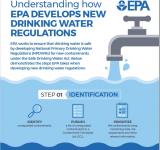SDWA Evaluation and Rulemaking Process
EPA has issued a number of drinking water regulations that strengthen public health protection since the 1996 amendments to the Safe Drinking Water Act (SDWA). These regulations include those designed to reduce risks from disinfection byproducts, arsenic, surface water pathogens such as Cryptosporidium, pathogens in groundwater, and water served onboard airplanes. EPA reviews existing national primary drinking water regulations and, as appropriate, revises them to improve public health protection.
SDWA requires processes to ensure that EPA establishes regulations for new contaminants that present a meaningful opportunity to improve public health protection. Every five years, EPA must publish a list of contaminants, known as the Contaminant Candidate List or CCL that are known or anticipated to occur in public water systems and are not currently subject to EPA drinking water regulations. EPA publishes draft CCLs for public comment and considers those prior to issuing final lists.
While the final CCL is typically used to determine which contaminants to monitor for under EPA’s Unregulated Monitoring Program (UCMR), its primary purpose is for making Regulatory Determinations (RegDet). Using the final CCL, EPA determines whether or not to regulate five or more contaminants using the RegDet Process. This involves determining:
- whether a contaminant may have adverse health effects
- whether a contaminant is found or substantially likely to be found in public water systems with a frequency and at levels of concern
- whether, in the sole judgment of the Administrator, there is a meaningful opportunity for health risk reduction through a national drinking water regulation.
EPA publishes preliminary regulatory determinations for public comment and considers those comments prior to making a final regulatory determination. If EPA makes a positive regulatory determination for any contaminant, it will begin the process to establish a national primary drinking water regulation, which typically includes a Maximum Contaminant Level (MCL).
Every six years, EPA reviews existing national primary drinking water regulations and, as appropriate, revises them to improve public health protection. Read More.
Learn more about How EPA Regulates Drinking Water Contaminants.

